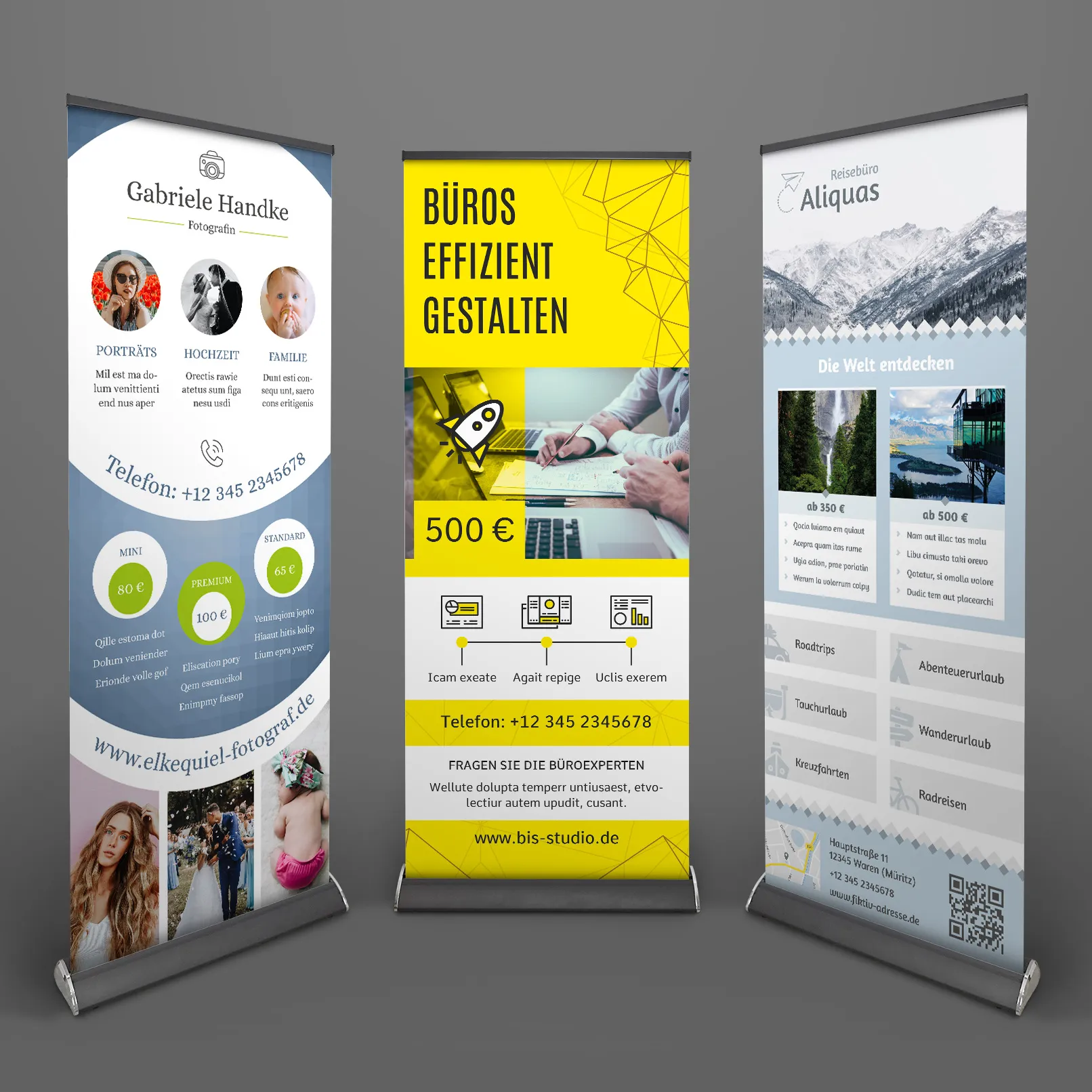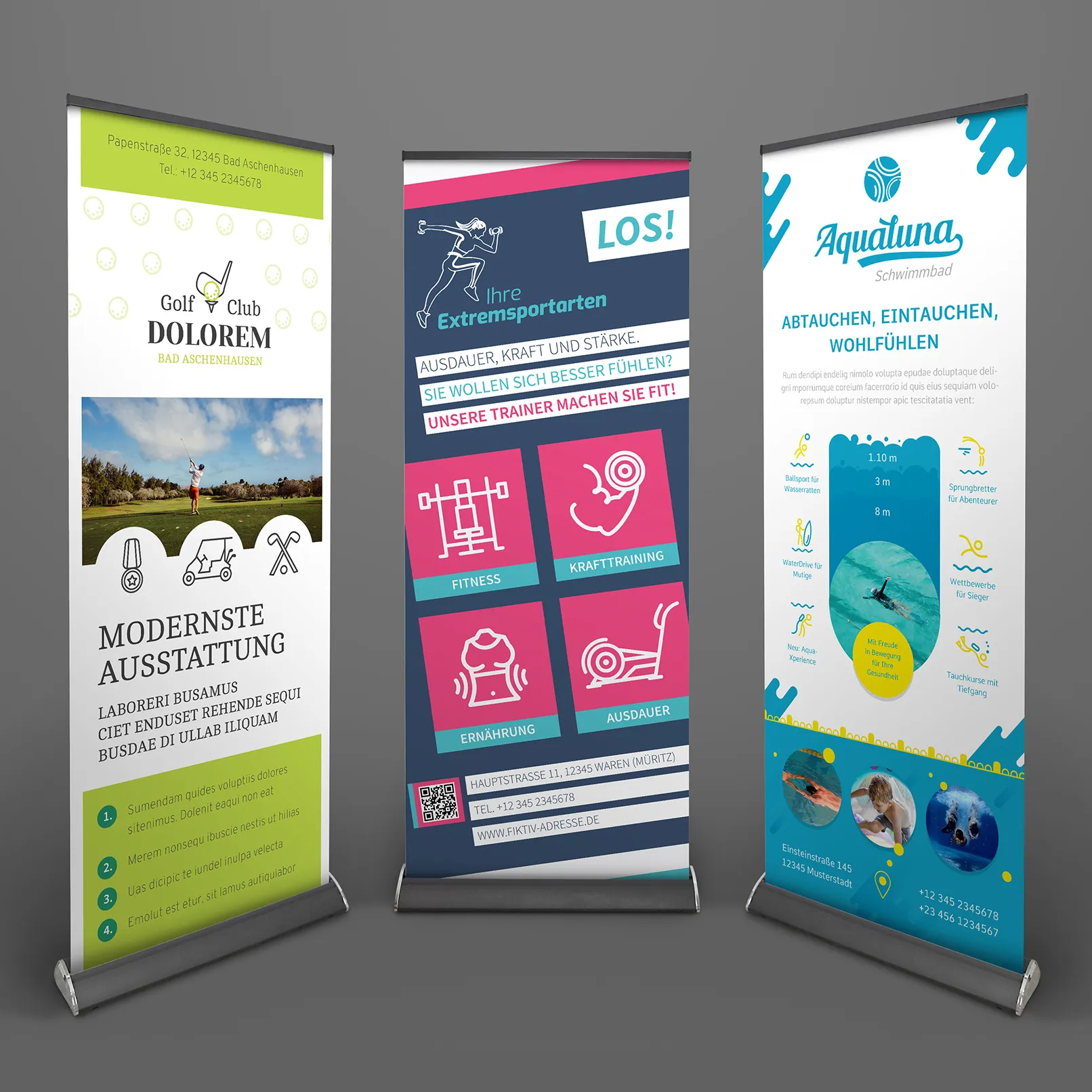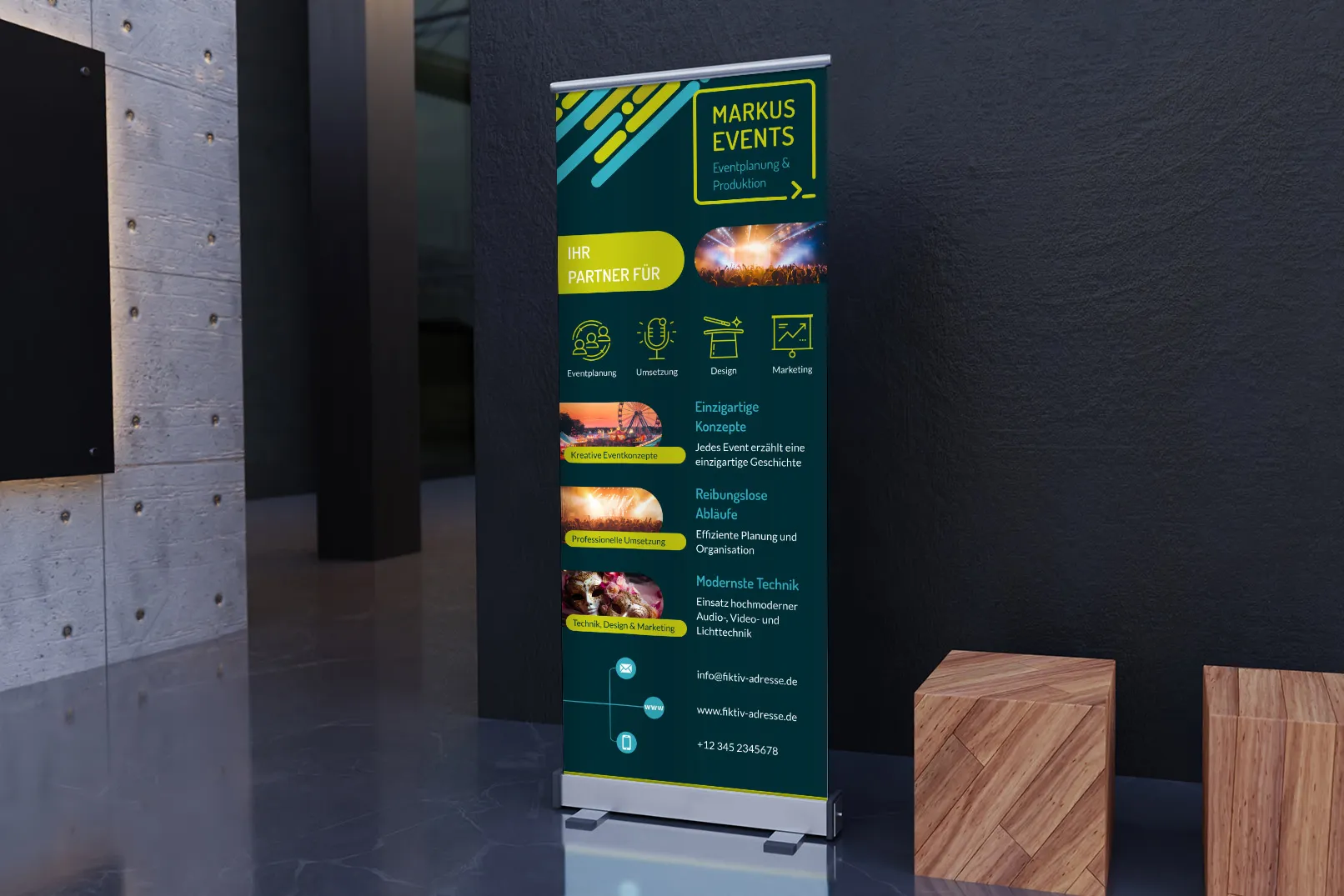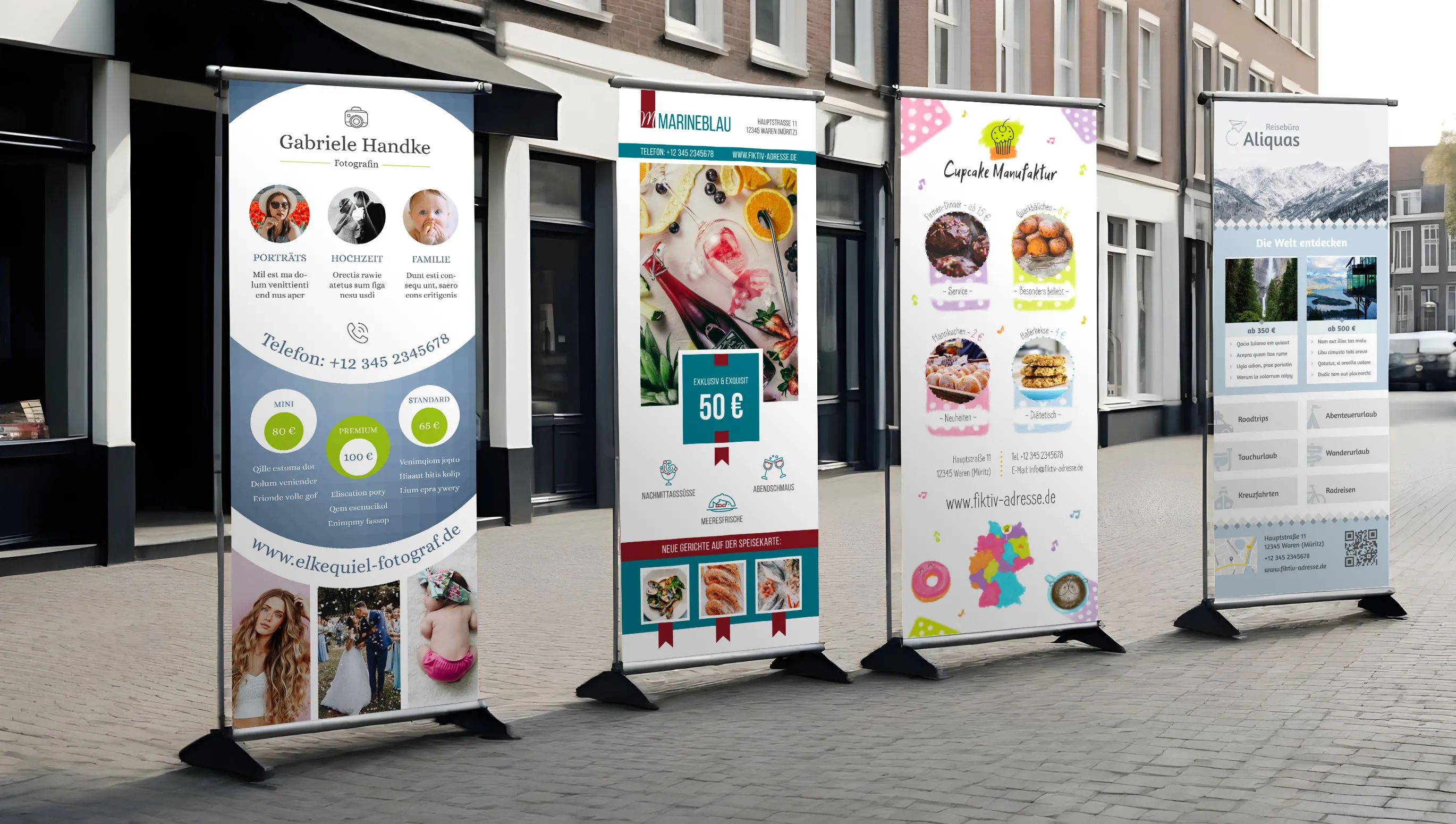Table of contents
What are roll-ups?
In this article, you will learn about roll-ups - their meaning, their variants and their production steps. You'll learn about the different materials used in the manufacturing process and get care tips to maximize the lifespan of this advertising medium.
Let's start with the definition of the term "roll-up" and the origin of its name. A roll-up is a portable advertising medium consisting of a vertical banner attached to a metal or plastic structure. It is often used at trade fairs, conferences and presentations to present advertising messages or information about a product or service.
The name "roll-up" is derived from the construction and the fastening mechanism. A roll-up has a special mechanism that allows the banner to be rolled up and unrolled within the device, similar to the process of "rolling up" or "rolling up". This makes it easier to transport and store the advertising material.
The history of roll-ups dates back to the 1990s, when the Swedish company Expand Media Systems developed portable banners under the brand name "Roll-Up" and launched them on the market for the first time. This innovative idea was very well received and formed the basis for the development of modern roll-ups. Over time, roll-ups have become an integral part of marketing and advertising strategies as they are easy to transport, simple to install and very effective at attracting the attention of the target group.
What types of roll-ups are there?
There are different variants of roll-ups, each designed for specific purposes and use situations. Some of the most common roll-up variants are
- Standard roll-ups: This is the most common roll-up variant, where only one side can be printed and is generally used for presentations, exhibitions, events and indoor advertising.
- Double-sided roll-ups: This variant of roll-ups allows information to be displayed on both sides of the banner. They are ideal for placement in passageways or at trade fairs, where passers-by can see the information from both sides.
- Large format roll-ups: These roll-ups are larger than the standard roll-ups and are often used to attract more attention at events with high visitor numbers or outdoors.
- Eco-friendly roll-ups: This variant of roll-ups is made from environmentally friendly materials such as biodegradable or recycled materials and is therefore more environmentally friendly.
- Interactive roll-ups: This is a new development in roll-ups that contain interactive elements such as touchscreens, QR codes or even built-in displays. They help to attract attention and interact with your target group.

How can you create roll-up banners? What is involved in the passive process of creating a roll-up?
In order to create a roll-up banner, certain steps need to be applied. The process of creating a roll-up consists of several phases, starting with the design and ending with the final assembly of the finished product. The most important phases are
- Design development: in this phase, the design of the advertising banner is developed taking into account the client's objectives and requirements. The visual appearance including logos, images, text and color scheme is taken into account. The layout is created in programs such as Adobe InDesign, Adobe Photoshop, Adobe Illustrator or CorelDRAW, Affinity Publisher or Affinity Designer.
- Layout preparation: Once the design has been developed, a layout must be prepared for printing, taking into account the size of the roll-up and the resolution requirements. The layout must be prepared according to the requirements for printing and output.
- Printing: In this phase, the layout of the roll-up is transferred to the printing material, using special printing machines and printing technologies. As a rule, large-format digital printing is used for roll-ups. A print shop will do this for you.
- Lamination (optional): To protect the print template from external influences such as scratches or moisture, lamination is recommended, in which a protective layer is applied to the print template.
- Mounting on the roll-up construction: The print material is attached to the special metal or plastic construction of the roll-up using adhesives or other fastening elements.
- Test and final inspection: After assembly, the roll-up is checked for print quality, correct assembly and general appearance.
- Packaging and delivery: The finished roll-up is packaged for transportation and delivered to the customer or place of use. Each of these stages plays an important role in producing a high-quality roll-up that effectively communicates the advertising message and captures the attention of the target audience.
Each of these stages plays an important role in the process of creating a high-quality roll-up that effectively conveys the advertising message and captures the attention of the target audience.

What software is needed to create a modern roll-up design?
Various graphic design and layout software tools are often used to create a modern roll-up design. Some of the most popular software solutions in this area are:
- Adobe Photoshop: this is one of the most widely used tools for editing graphics and photos. Photoshop offers a variety of image creation and editing features that allow designers to create high-quality graphic elements for roll-ups.
- Adobe Illustrator: Illustrator is used to create vector graphics and allows the creation of logos, illustrations and other graphic elements that can be used in roll-up design. Vector graphics are ideal for creating elements that can be scaled without loss of quality.
- Adobe InDesign: This professional layout application is often used to create layouts for promotional materials, including roll-ups. InDesign offers powerful tools for creating layouts, adding text and images, and preparing documents for print.
- CorelDRAW: This is an alternative tool for working with vector graphics that offers similar features to Photoshop and Illustrator. CorelDRAW is also often used for designing roll-ups and other promotional materials.
Requirements for the roll-up design
Yes, the roll-up design before printing must meet certain requirements to ensure a high-quality result. Here are some of the most important requirements for the roll-up design:
- Size and proportions: Make sure the design is the right size and proportions for printing. This usually means using a template or adjusting the document size in the graphic design software.
- Image quality: The design must have sufficient image quality for high-quality printing. The recommended quality is usually 700 dpi (dots per inch) to ensure sharpness and detail when printing on large formats.
- Color model: Make sure that the color model of your design meets the printing requirements. Normally, CMYK is used for professional printing, as opposed to RGB, which is used for screens.
- Spacing and bleed: Make sure that your design includes the spacing for bleed and the necessary clearances for text and design elements that will not be cut off during printing.
- Fonts: Use fonts that are easy to read and suitable for printing in large formats. Make sure that all fonts used are embedded or included in the design file.
These requirements may vary slightly depending on the print service provider or print shop. It is therefore recommended that you contact them before printing to get exact information about the roll up design requirements.

What do you need to know before printing your roll up design? What unforeseen circumstances could arise?
Before printing the roll-up design, it is important to consider some important points and possible unforeseen circumstances:
- Check the quality and resolution of the images: Ensure that all images used are of sufficient resolution to be printed at the desired size. A low resolution can lead to blurred or pixelated images.
- Check the color space and color settings: Ensure that the colors used meet the requirements of the design and are reproduced correctly on the print material. Incorrect color settings can lead to differences between the expected and actual colors.
- Check the print type and print parameters: Clarify the requirements for the print type (digital or offset) and ensure that the chosen material and print parameters meet your requirements and expectations.
- Check the layout for errors: Check the rollup layout carefully for errors in the text, placement of elements and other details. Even small errors can have a negative impact on the print quality.
- Turn to professionals: If you have no experience in creating print files, it is advisable to ask a professional designer or print shop for help. They can help you take all the subtleties into account and avoid potential problems.
Unforeseen circumstances that can occur when printing a roll-up include errors in the layout file, color deviations during printing, problems with print or material quality, and delays due to technical problems or unforeseen situations at the print shop. Therefore, it is important to be prepared for possible delays and have time reserves to fix problems when they occur.
Which materials are best suited for printing a roll-up image?
Special materials are generally used for printing images on roll-ups, which ensure good print quality, durability and user-friendliness. The most common materials used for printing on roll-ups are
- Polyester fabric: this is one of the most popular materials for roll-ups. Polyester offers excellent print quality, vibrant and rich colors and good resistance to abrasion and fading.
- Polypropylene films: These films are characterized by their strength, flexibility and moisture resistance. They also offer brightness and image sharpness, making them a good choice for roll-ups used outdoors or in humid conditions.
- Banner materials: Banner materials are usually made of vinyl or other synthetic materials. They are particularly robust and resistant to external influences, making them the ideal choice for roll-ups that are to be used outdoors.
- Paper: Lightweight paper can be used for low-cost or temporary roll-ups. However, it is less durable and can be damaged by intensive use or in humid conditions.
The choice of material will depend on the specific requirements of your project, such as the location (indoor or non-windy outdoor), budget, print quality and durability. When selecting the material, it is important to take all these factors into account in order to achieve the best result.
In which cases should which materials be used to print a roll-up?
The choice of materials for roll-ups depends on the specific requirements and conditions of use. Below are some recommendations as to which materials are best suited in which cases:
- For internal events and exhibitions: - For internal events and exhibitions where the roll-up is displayed in a room that is not exposed to aggressive environmental influences, polyester fabrics or polypropylene films should be used. They offer high print quality and bright colors.
- For outdoor events: - For outdoor use or in conditions with increased humidity and aggressive environments, choose more robust materials such as vinyl banner fabrics or plastic films. They are highly resistant to moisture, wind and UV radiation and are therefore ideal for outdoor use.
- If the roll-up is only to be used temporarily or the budget is limited, the use of paper roll-ups can be considered. These are generally less expensive, but less durable and more susceptible to damage.
- If light weight and easy transportation are important, choose lighter materials such as polyester fabric or lightweight polypropylene film. They offer good print quality and are easy to assemble and transport. When selecting materials for roll-ups, it is important to consider the project-specific requirements, the conditions of use and the budget.

How do I maintain a roll-up so that it lasts longer?
Maintaining the roll-up helps to keep it in good condition and extend its lifespan. Here are some tips on how to care for your roll-up:
- Keep the roll-up in a sleeve or bag: Keep the roll-up in a cover or special bag to protect the material from dust, dirt and moisture.
- Avoid mechanical damage: Avoid bumps and bends to prevent damage to the mechanics and material.
- Clean the roll-up when necessary: Clean dust and dirt from the roll-up with a soft brush or dry cloth when necessary. Avoid using abrasive cleaners or liquids that could damage the material or the print.
- Avoid direct sunlight: Do not expose the roll-up to direct sunlight for long periods of time to prevent the colors from fading and the material from deforming.
- Store the roll-up in a dry place: Make sure that the roll-up is completely dry after use before rolling it up and storing it. Avoid storing in damp conditions to prevent mold or fungal growth on the material.
- Check the mechanism and structure of the roll-up: Check the mechanism of the roll-up regularly for damage or wear. If problems occur, these must be rectified immediately or have them rectified by specialists.
The use of mild, non-toxic and non-abrasive cleaning agents is recommended for cleaning roll-ups. Here are some safe and effective options:
- Clean water: simply wiping the roll-up with a damp, soft cloth soaked in clean water may be enough to remove dust and light dirt.
- Gentle detergents: If the roll-up is very dirty or stained, you can dilute a mild detergent in water. Choose gentle formulas that do not contain any aggressive chemical substances.
- Special cleaning agents for advertising materials: There are specialized cleaning agents for advertising materials on the market, such as sprays or cleaning wipes that have been specially developed for materials used in advertising and marketing.
The use of abrasive cleaning agents, acetone, solvents or other aggressive chemical substances that can damage the material or the print on the roll-up is not recommended. Also avoid using aerosol sprays that contain strong solvents that can negatively affect the material and the environment. Before using a cleaning agent, it is important to check its compatibility with the roll-up material and carry out a test on a small area to ensure that there is no negative reaction.
How long does it take to familiarize yourself with the software to create appealing roll up designs?
In terms of mastering graphic programs to create roll-up designs, three types of students with different levels of experience and knowledge can be distinguished:
- To learn professional software that can also be used to create roll-ups, you will need about 1-2 weeks without previous experience. That's a long time, of course, and I suppose it should be quicker, right?
- Here's the good news: with the help of our roll-up templates, everything is already prepared for you. Adjust the colors, images and text of our roll-up templates and you'll have your professional design ready in minutes. Does that sound better to you?
Please note that these times are approximate and may vary depending on individual skills, learning speed and availability of learning materials.
Roll-up templates
Don't forget the roll-up templates! After reading this article, you will have a basic idea of how roll-ups are created: from the idea to the finished product. I hope you found this information useful. Remember that creating an appealing roll-up is a process that takes time and effort. You can use this time to learn new software and purchase licenses to use it. But there's another option: use our roll-up templates, which are available to buy and download immediately. Our professional designers have developed perfect variants for you that meet your company's requirements. Let's promote your company together!


